Many people wonder how long service dog training takes. Of course it depends on the job that the dog is being trained for, the dog breed and the natural aptitude that the dog has. And last but not least, the skill and patience of the dog trainer!
The usual minimum time is 120 hours over 6 months, although many service dog training programs will take longer.
Cost is another issue; whether you can get a trained dog from a service dog program or whether you train a dog yourself, at the end of the day you be looking at $3000 to $5000 for the dog plus $10,000 to $20,000 for the training period.
First of all, let’s take a look at each service dog training pathway – the job that the dog will end up doing. There are a number of ways that service dogs can be trained to provide assistance to humans.
Service Dog Training
Guide dogs.
The most common type of service dog is the guide dog for the visually impaired owner. Guide dogs are extremely highly trained, as their owner’s safety is in their paws.
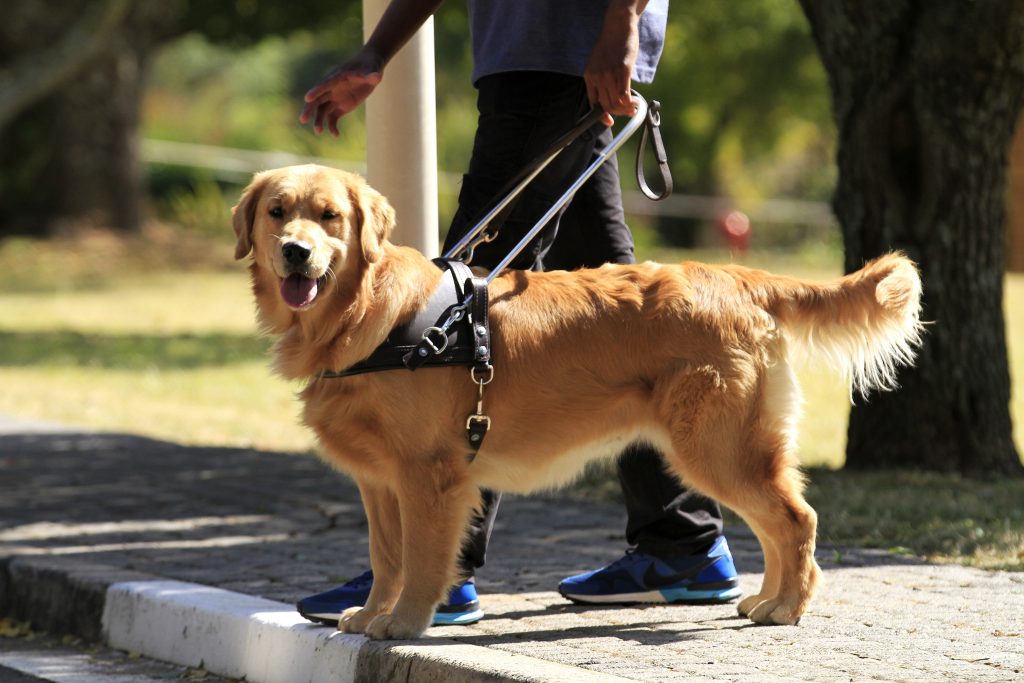
Hearing dogs.
These service dogs act as “ears” for those owners with hearing issues. They can alert their owner to a doorbell, a person calling, an alarm, and approaching cars in the street.
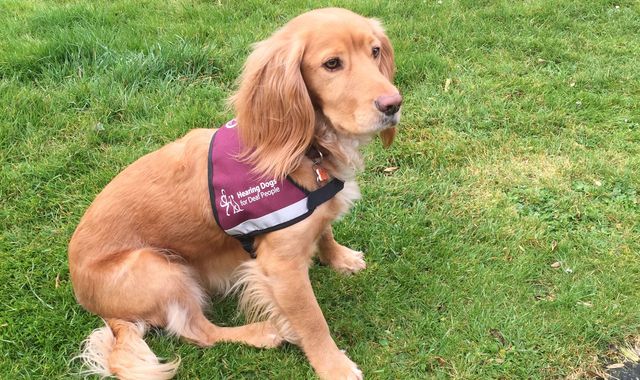
Medical detection dogs.
Dogs trained as medical detection dogs cover a wide array of specialist jobs.
Cancer detection – dogs can be trained to sense particulsr cancers at a very early stage.
Diabetes – service dogs can smell hypo- or hyperglycemia before it becomes dangerous.
Seizure alert, and seizure support, which are 2 different things. Seizure alert dogs can detect an imminent seizure as much as 30 minutes beforehand, allowing their owner to get to a safe place. On the other hand, seizure support dogs can attract attention of other humans to their owners, protect them, and help bring them round by licking their hands and face.
Allergy alert dogs – these dogs have been trained to detect the smallest traces of their owner’s allergens in food and their surroundings, alerting their owners of potential danger.

Autism support dogs. These animals provide a focus for their young owners, providing emotional support in times of stress, helping to prevent them from running away, and even helping to find them if they do!
Psychiatric service dogs.
These are referred to as PSD dogs, and can help with PTSD, anxiety, panic attacks
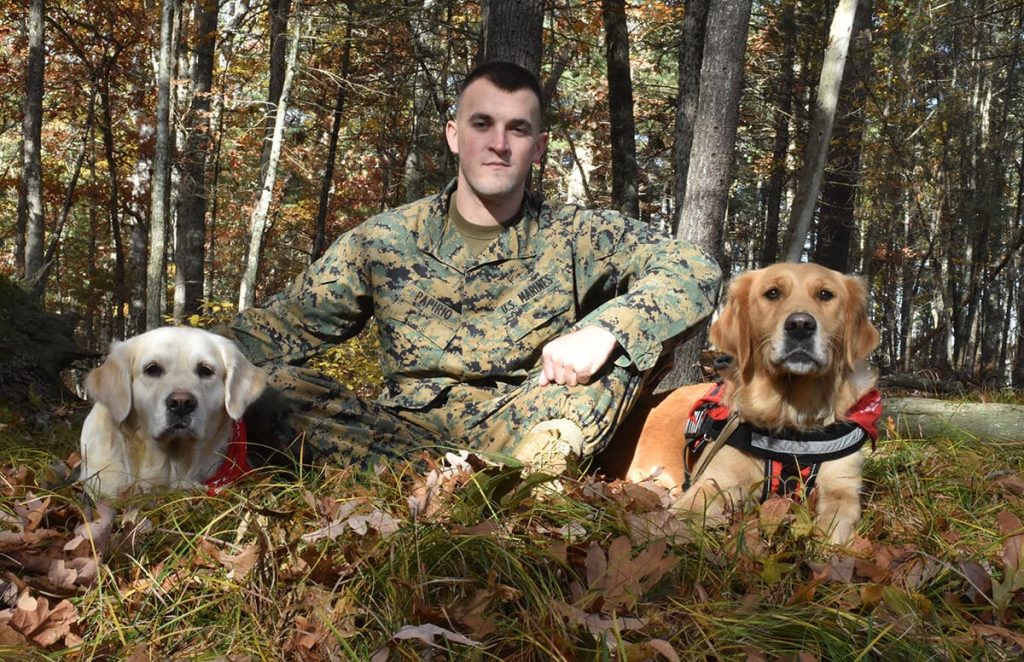
Mobility support dogs.
These dogs are trained to provide assistance to owners with mobility issues, in one of 2 ways;
- They may carry out a task on their own to help the owner, such as opening doors, and fetching items like wallets, papers or items of clothing.
- They may provide physical support and bracing for their owner to move themselves in and out of bed, a wheelchair, or a shower.
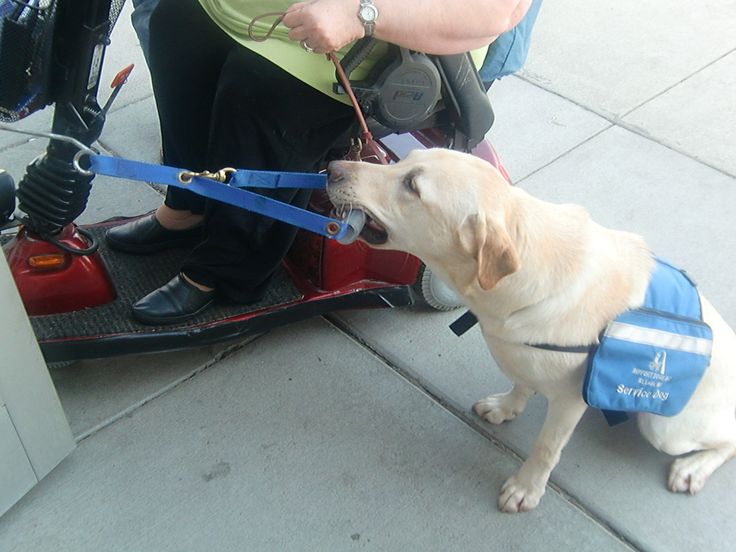
Military and border control support dogs.
These dogs can be trained as bomb or explosive detection dogs, drug sniffer dogs, and for detecting illegal migrants and stowaways.
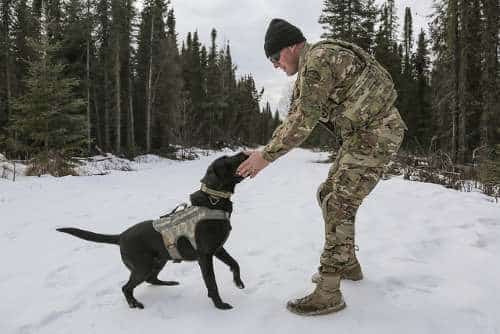
Service Dog Training
BUT before you look at getting a service dog, you need to think about WHY a dog will help you – after all, you will be taking on an extra responsibility for looking after the service dog.
Here are 5 basic questions that will help you;
- 1. Will I be able to afford the costs involved in getting and keeping a service dog for 10 to 15 years?
You may apply for a service dog from a service dog training program, or else you may want to train your potential service dog yourself. Most service dog programs will charge $5000 + for a dog, plus up to $20,000 for the specialist training. Some specialist dogs may cost more if they are trained in 2 areas.
Service Dog Training
If you decide to train a dog yourself, you have the costs of the dog itself, all the veterinary costs and testing, temperament testing, transport, initial training, advanced training, any necessary titling/certifications all gear and equipment, and any other required supplies like food,medical supplements and other “incidentals.”Read on below
about how to “certify” a dog you have trained yourself.
And you can’t cut corners when choosing a dog – you can’t just pick one up from the local dog home. The dog’s temperament is vital. Most dogs will not be able to learn the skills required to become a useful service dog.
The best route here is to buy a purebred dog from a reputable breeder who has a history of producing dogs that do well as service dogs. Expect to pay $1000 to $3000 for such a dog, depending on the breed and size.
By taking this route, you will have a very high chance of getting a dog that will do well and be able to learn the required training. That’s the start!
Next, even if you are planning to train the dog yourself, you will need to include the services of a professional service dog trainer at some point, to make sure you are training the dog correctly. A professional will usually charge $60 – $120 per hour.
After training is complete, you then need to reckon with $1200+ per year to feed your dog, get veterinary treatment when needed, insurance, bedding and grooming supplies. That’s every year for up to 15 years.
If you have carried out your own service dog training, you can expect to have invested over 120 hours of training time. Sometimes more. Sometimes less, depending on the individual dog and the degree of difficulty of the tasks to be accomplished.
HOW will you know if your dog is ready to take on the full role of service dog for you?
One way of checking is to look at the Public Access Test as designed and administered by the International Association of Assistance Dog Partners (IAADP).
Service Dog Training
The following is quoted directly from the IAADP website;
Start quote;
“IAADP Minimum Training Standards for Public Access
1. Amount of Schooling: an assistance dog should be given a minimum of one hundred twenty (120) hours of schooling over a period of Six Months or more.* At least thirty (30) hours should be devoted to outings that will prepare the dog to work obediently and unobtrusively in public places.**
2. Obedience Training: a dog must master the basic obedience skills: “Sit, Stay, Come, Down, Heel” and a dropped leash recall in a store in response to verbal commands and/or hand signals.
3. Manners: a dog must acquire proper social behavior skills. It includes at a minimum:
No aggressive behavior toward people or other animals – no biting, snapping, snarling, growling or lunging and barking at them when working off your property.
No soliciting food or petting from other people while on duty.
No sniffing merchandise or people or intruding into another dog’s space while on duty.
Socialize to tolerate strange sights, sounds, odors etc. in a wide variety of public settings.
Ignores food on the floor or dropped in the dog’s vicinity while working outside the home.
Works calmly on leash. No unruly behavior or unnecessary vocalizations in public settings.
No urinating or defecating in public unless given a specific command or signal to toilet in an appropriate place.
4. Disability Related Tasks: the dog must be individually trained to perform identifiable tasks on command or cue for the benefit of the disabled human partner. This includes alerting to sounds, medical problems, certain scents like peanuts or situations if training is involved.
For a definition of a “task” and “individually trained,” and “what is not a task” and many examples of tasks performed by different kinds of assistance dogs, Click Here.
5. Prohibited Training: Any training that arouses a dog’s prey drive or fear to elicit a display of aggression for guard or defense purposes is strictly prohibited. Non aggressive barking as a trained behavior is permitted in appropriate situations. (See IAADP’s ban on the enrollment of protection trained, attack trained or aggressive dogs as an assistance dog with our organization. Click Here).
6. A Trainer’s Responsibilities: Trainers function as ambassadors for the assistance dog movement. This includes a disabled owner trainer, a provider’s staff or a volunteer with a puppy or adult dog “in training.” It also includes an assistance dog partner or able bodied facilitator helping a disabled loved one to keep up an assistance dog’s training. At a minimum, you should:
Know pertinent canine laws (i.e. leash laws and public access laws)
Ensure the dog is healthy, flea free and the rabies vaccination is up to date.
Take time to make sure your dog is well groomed and free of any foul odor.
Show respect and consideration to other people and property.
Use humane training methods; monitor the dog’s stress level; provide rest breaks.
Carry clean up materials. Arrange for prompt clean up if a dog eliminates or gets sick.
Be polite and willing to educate the public about assistance dogs and access rights.
* The 120 hours of schooling includes the time invested in homework training sessions between obedience classes or lessons from an experienced dog trainer. ** Eligibility for Certification from a provider who supports IAADP’s Minimum Training Standards for Public Access may require you turn in a weekly training log to document your dog received a minimum of 120 hours of schooling over a period of six months or more. (See Sample Training Log)” end quote.
Service Dog Training
- 2. Are you prepared and able to care for the dog every singe day (or arrange for someone else to do this from time to time)? It’s like having a small child that never grows up. The animal will need to be exercised, cleaned, and fed.
And this is every day. Even if it’s raining, snowing, or you don’t feel like going out – your dog will need continuous care.
- 3. Can you deal with always being the center of attention with your dog? Every time you go out with your service dog, people will look at you, point you out, and sometimes just plain gawp at you. And then they will come up to you and ask if they can pet your dog, even if it has a “Do Not Pet” sign on its jacket!
Then complete strangers will come over to you and start conversations about the service dog, why you need it, what’s wrong with you, and how the dog works. And just because you have a service dog, do not expect to be allowed access to every establishment that you would like to go into.
You must make sure that your service dog is well-behaved in public, on-task and looking good. By having a service dog yourself, you become an ambassador for all service dogs everywhere. Are you up to that challenge?
Service Dog Training
- 4. Are you able (and willing) to keep up your service dog’s training, and also keep it socialized adequately? If you get a service dog from a program, you can’t just take it home and expect him or her to maintain their level of performance over years without any input from you.
It’s like buying an automobile – you have to change the oil, get new tires, carry out servicing, etc. Or maybe a better analogy is buying a racehorse – it may be fast when you buy it, but if you don’t keep up the training, it will soon lose it’s speed and become like any other horse.
Service dogs are highly trained, with a very special skill set. You must work continuously to maintain that training and your dog’s public social skills. And the more specialized your dog’s skills, the harder you will need to work.
Service dogs are also animals, and can have “off days” just like humans. You have to be able to maintain a level playing field for the dog, consistent rules and consistent behavior.
- 5. Lastly, are you prepared to deal with a bit of conflict? You may not have expected this, but you will probably come across some resistance and conflict with a service dog, especially if your disability is not obvious.
When out and about in public, you may receive varying degrees of service, ranging from “normal” through “rude” all the way to “outright abusive”. Some people don’t like dogs, and some especially dislike what they perceive as someone with a dog getting special access or privileges. You must be prepared to deal with this in a dignified and calm manner.
SUMMARY – having a service dog can change your life in many ways for the better, but service dog training is not easy nor cheap, and owning a service dog involves many responsibilities that last for years. Only YOU can know if you are up to the challenge of ownership, and if the potential benefits outweigh the burdens!
HERE is a list of dog trainers at the USA service dog registration website.


